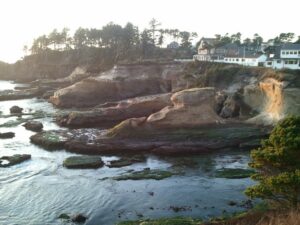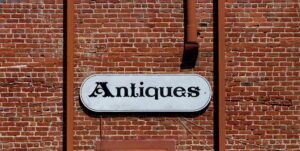By Karissa Courtney

Some fun surfing terms:

When thinking of surfing, it’s not often that Oregon is considered. California, Mexico, and Hawaii are usually first to pop up, and most people think that those are the best places to go in/near the US. However, Oregon Coast surfers beg to differ and offer that Oregon has some of the best waves in the world on the right day, and it’s one of the best kept secrets..shhh. A local’s favorite is Cape Kiwanda, and a great spot for beginners is in Manzanita, called Short Sands.
WHAT GEAR DO YOU NEED?
- Thick wetsuit, 5/4 or 4/3mm – the larger number is the thickness of the rubber in the chest, and the smaller number is usually the arms and legs
- Booties
- Gloves
ANATOMY OF A SURFBOARD

TYPES OF SURFBOARDS

- SHORTBOARD – The modern shortboard is typically less than 7 feet long and made for aggressive surfing on critical parts of the wave. They usually have a sharp nose, thinner rails, and high rocker which make it better for high levels of maneuverability.
- LONGBOARD – The most traditional surfboard shape. They typically range from 8 – 12 feet in length, at least 2.5 inches thick, and 20 inches wide. These boards paddle well and are great for beginners learning how to surf.
- FUNBOARD – This term describes a larger surfboard with a lot of volume and range in length from 6 – 8 feet. These are great transition boards for anyone wanting to move down a size and since they are wider, they can be easily balanced on.
- FISH – This board originates from the knee board. They are shorter, wider and flatter than a shortboard and they work well in small surf. They paddle very well and carry speed through flat sections of the wave.
- GUN – These surfboards are best for large/big wave days. They range in length from 6.5 -10 feet with bigger boards for increasing wave sizes, allowing the surfer to paddle fast enough to catch heavy, fast moving waves. Guns are difficult to ride and require experience.. Gun shapes are difficult to ride and require a lot of experience.
- HYBRID – The hybrid board mixes the design of two board types. For example, the hybrid fish mixes the shortboard design with added width and tail design of a fish.
- OTHER – There are a few other surfboard shapes that are less common. Some examples include, single fin shortboards, bonzers, displacement hulls, alaias, tow in boards and stand up paddle boards.
(all surfboard types from http://www.surfscience.com/)

NOT SURE WHAT SIZE OF BOARD TO GET? CHECK THE DIAGRAM BELOW:


Charts from https://www.surfertoday.com/
FUN FACT: Today, most surfboards are made with a polystyrene (aka styrofoam) core, but they originally were made of solid wood, and later lighter balsa wood was used for the core.
Now that we have a background in surfing, I reached out to my good friend, Buddy Pickett (again!) who is an avid surfer on the Oregon Coast and he told me all about his experiences.
WHEN IS THE BEST TIME TO SURF IN OREGON?
My favorite time to surf in Oregon is summer and early fall, you get these really long days and still mornings. My favorite time is dawn – right when everything starts waking up, or at the end of the day when the wind dies down.
WHAT DO YOU USUALLY WEAR?
Water is usually the coldest in the summer when we get north winds. The water can get down to 46-48 degrees, but rarely colder than that. In those times you are most comfortable in a full suit with a hood, booties, and gloves. I don’t wear gloves often, only when it’s absolutely necessary. When paddling out and duck diving waves the hood makes a huge difference, especially because you can get brain freezes (what surfers call ice cream head aches).
WHAT ARE SOME TIPS YOU HAVE FOR PEOPLE WANTING TO TRY SURFING?
Tips I have for people that are wanting to learn to surf is to do some research depending on the area that they are in and to take a lesson with their local surf shop. It is a great way to get an introduction into surfing, If you did not grow up spending time in the ocean there are some big mental and physical hurdles that must be passed in order to gain the skills necessary to be comfortable in the water.

HAVE YOU EVER BUILT A SURF BOARD? WHAT IS THAT LIKE?
Building a surfboard is a complex and technical process. Surfboards were traditionally built out of wood, but as time progressed eventually they switched to foam – the most common is polyurethane. Building a surfboard is an art form and craft that has been perfected and modified over time by the great shapers of the world. It takes years to learn to shape a proper surfboard. I have been lucky to have several friends that are shapers in the industry who have let me use their tools and workplace to learn a small bit about the art of shaping. Using a planer and various shaping tools, the surfboard is carved out and built by hand. I really enjoy the process of surfboard design and how certain boards will work in different conditions and specific waves.
WHAT TIDES ARE BEST FOR SURFING?
I check the tides daily. There is usually a magic window somewhere between low and high tide where it’s just right.
WHAT’S YOUR SCARIEST STORY?
The scariest moment I’ve ever had surfing on the Oregon Coast, was the time I was caught in a strong rip current near Cape Kiwanda. My friend and I paddled for what must have been an hour and a half just holding ground. If we took a five second break we’d see ourselves creeping back further along the rocks. The same day someone had been sucked out several miles and had to be picked up by search and rescue. Eventually the current let up and we were able to make it into the break zone and got pushed in. I think about that often when my arms are tired from paddling – that if it weren’t for being in that position I never would have been able to paddle that hard and fast for such a continuous amount of time.
DO YOU HAVE ANY OTHER FAVORITE PLACES TO SURF?
My favorite places to travel to surf are Baja California and British Columbia. Both are just a state away and there is a lot of good surf in either direction.
WHAT DO YOU LIKE SO MUCH ABOUT SURFING?
My favorite part about surfing are the experiences I have and the way that it adds to my life. I like being in and around the ocean because of the way that it makes me feel and I love the challenge and feeling that riding a wave brings.
Some good surf shops along the coast:
Cleanline Surf, Cannon Beach – A larger company, but they still have a nice selection. They have used boards, new boards, rentals, lessons, and apparel.
Moment Surf Company, Pacific City – the culture, board selection, and location make it super great. They also offer a range of rentals including boards and wetsuits.
Oregon Surf Adventures, Astoria – They have lessons and camps for those wanting to learn!
Ossies Surf Shop, Newport – They have a great used board selection and carry Oregon shapers boards.
Safari Surf Town, Lincoln City – This surf shop doesn’t just have the regular gear. They also have fat tire rentals and kayak adventures! Perfect if your group isn’t all keen on surfing.
Seaside Surf Shop, Seaside – A variety of apparel and gear, plus lessons and rentals!


